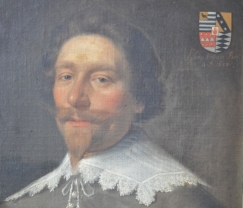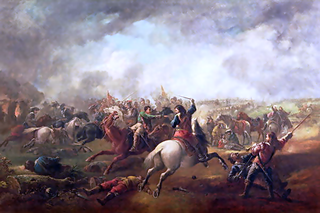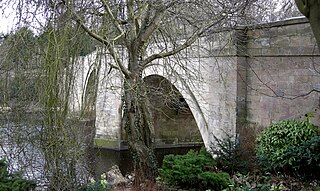Related Research Articles

The English Civil War (1642–1651) was a series of civil wars and political machinations between Parliamentarians ("Roundheads") and Royalists ("Cavaliers"), mainly over the manner of England's governance and issues of religious freedom. It was part of the wider Wars of the Three Kingdoms. The first (1642–1646) and second (1648–1649) wars pitted the supporters of King Charles I against the supporters of the Long Parliament, while the third (1649–1651) saw fighting between supporters of King Charles II and supporters of the Rump Parliament. The wars also involved the Scottish Covenanters and Irish Confederates. The war ended with Parliamentarian victory at the Battle of Worcester on 3 September 1651.

Robert Devereux, 3rd Earl of Essex, KB, PC was an English Parliamentarian and soldier during the first half of the 17th century. With the start of the English Civil War in 1642 he became the first Captain-General and Chief Commander of the Parliamentarian army, also known as the Roundheads. However, he was unable and unwilling to score a decisive blow against the Royalist army of King Charles I. He was eventually overshadowed by the ascendancy of Oliver Cromwell and Thomas Fairfax and resigned his commission in 1646.

Heworth is part of the city of York in North Yorkshire, England, about 1 mile (1.6 km) north-east of the centre. No longer in general referred to as a village, "Heworth Village" is now the name of a specific road. The name "Heworth" is Anglo-Saxon and means a "high enclosure".

Thomas Fairfax, 3rd Lord Fairfax of Cameron, also known as Sir Thomas Fairfax, was an English politician, general and Parliamentary commander-in-chief during the English Civil War. An adept and talented commander, Fairfax led Parliament to many victories, notably the crucial Battle of Naseby, becoming effectively military ruler of England, but was eventually overshadowed by his subordinate Oliver Cromwell, who was more politically adept and radical in action against Charles I. Fairfax became unhappy with Cromwell's policy and publicly refused to take part in Charles's show trial. Eventually he resigned, leaving Cromwell to control the country. Because of this, and also his honourable battlefield conduct and his active role in the Restoration of the monarchy after Cromwell's death, he was exempted from the retribution exacted on many other leaders of the revolution.

William Cavendish, 1st Duke of Newcastle upon Tyne, KG, KB, PC was an English courtier and supporter of the arts. He was a renowned horse breeder, as well as being patron of the playwright Ben Jonson, and the intellectual group known as the Welbeck Circle.

John Lambert, also spelt 'Lambart' was an English Parliamentarian general and politician. Widely regarded as one of the most talented soldiers of the period, he fought throughout the Wars of the Three Kingdoms, and was largely responsible for victory in the 1650 to 1651 Scottish campaign.

Ferdinando Fairfax, 2nd Lord Fairfax of Cameron MP was an English nobleman and politician who sat in the House of Commons at various times between 1614 and 1648. He was a commander in the Parliamentary army in the English Civil War.

George Goring, Lord Goring was an English Royalist soldier. He was known by the courtesy title Lord Goring as the eldest son of the first Earl of Norwich.

Sir John Hotham, 1st Baronet of Scorborough Hall, near Driffield, Yorkshire, was an English Member of Parliament who was Governor of Hull in 1642 shortly before the start of the Civil War. He refused to allow King Charles I or any member of his entourage to enter the town, thereby depriving the king of access to the large arsenal contained within. Later in the Civil War he and his son John Hotham the younger were accused of treachery to the Parliamentarian cause, found guilty and executed on Tower Hill.

The First English Civil War was fought in England and Wales, from August 1642 to June 1646. It forms one of the conflicts known collectively as the 1638 to 1651 Wars of the Three Kingdoms, which also took place in Scotland and Ireland. These include the 1638 to 1640 Bishops' Wars, the Irish Confederate Wars, the Second English Civil War, the Third English Civil War, and the Cromwellian conquest of Ireland. It is estimated that from 1638 to 1651, 15–20% of all adult males in England and Wales served in the military, and around 4% of the total population died from war-related causes, compared to 2.23% in World War I. These figures are important in understanding the impact of the conflict on society, and the bitterness it engendered.

The first Siege of Hull marked a major escalation in the conflict between King Charles I and Parliament during the build-up to the First English Civil War. Charles sought to secure the large arsenal held in Kingston upon Hull, East Riding of Yorkshire. He first approached the town in late April 1642, but was rebuffed by the town's Parliamentarian governor, Sir John Hotham. Charles retreated to York, but in July he received news that Hotham might be willing to hand over the town if the Royalists approached with a large enough force that Hotham could surrender with his honour intact.
Sir Hugh Cholmeley, 1st Baronet was an English landowner and Member of Parliament who sat in the House of Commons at various times between 1624 and 1643. He was initially a Parliamentarian but later a Royalist leader during the English Civil War. His name is sometimes spelled Cholmley.
The Battle of Seacroft Moor took place in Whinmoor moor near the village of Seacroft, north-east of Leeds in West Riding on 30 March 1643 during the First English Civil War. In the battle, a Parliamentarian force commanded by Lieutenant-General Thomas Fairfax was decisively beaten by a Royalist cavalry force commanded by George Goring.
The unsuccessful second Siege of Hull by the Royalist Earl of Newcastle in 1643 was a victory for Parliament at the high point of the Royalist campaign in the First English Civil War. It led to the abandonment of the Earl of Newcastle's campaign in Lincolnshire and the re-establishment of Parliament's presence in Yorkshire.
The First English Civil War started in 1642. By the end of the year neither side had succeeded in gaining an advantage, although the King's advance on London was the closest Royalist forces came to threatening the city.
The Treaty of Neutrality signed on 29 September 1642 by Lord Fairfax for Parliament and Henry Bellasis for the Royalists, the two Knights of the Shire who represented Yorkshire in Parliament, with the support and agreement of other gentlemen of the county, in the hope of avoiding civil war in Yorkshire. The treaty was disowned by Parliament on 4 October 1642.

Sir William Fairfax (1609–1644), was an officer in the Parliamentary army during the English Civil War.

The Capture of Wakefield occurred during the First English Civil War when a Parliamentarian force attacked the Royalist garrison of Wakefield, Yorkshire. The Parliamentarians were outnumbered, having around 1,500 men under the command of Sir Thomas Fairfax, compared to the 3,000 led by George Goring in Wakefield, but successfully stormed the town, taking roughly 1,400 prisoners.
The Battle of Tadcaster took place during the First English Civil War on 7 December 1642, when a Royalist force attacked the Parliamentarian garrison of Tadcaster, Yorkshire, which was held by between 900 and 1,500 soldiers under the command of Ferdinando Fairfax, Lord Fairfax. Newcastle marched out of York on 6 December, and split his force of 6,000 into two; he took 4,000 infantry down the main York–Tadcaster road to attack the town from the east, while sending a deputy, the Earl of Newport, with a further 1,500 to circle around and trap the Parliamentarians by attacking from the north-west.

The Battle of Piercebridge was fought on 1 December 1642 in County Durham, England, during the First English Civil War. The Earl of Newcastle was advancing with an army of 6,000 from Newcastle upon Tyne to York to reinforce the local Royalists. Aware of his approach, the Parliamentarians defended the main crossing over the River Tees, at Piercebridge. Under the command of Captain John Hotham, around 580 troops had barricaded the bridge.
References
- Attribution
- This article incorporates text from a publication now in the public domain : Chisholm, Hugh, ed. (1911). "Fairfax of Cameron, Thomas Fairfax, 3rd Baron". Encyclopædia Britannica . Vol. 10 (11th ed.). Cambridge University Press. p. 130.
 This article incorporates text from this source, which is in the public domain :Lewis, Samuel (1831). A topographical dictionary of England: comprising the several counties, cities, boroughs, corporate and market towns, parishes, chapelries, and townships, and the islands of Guernsey, Jersey, and Man, with historical and statistical descriptions; illustrated by maps of the different ... Vol. 4. p. 601.
This article incorporates text from this source, which is in the public domain :Lewis, Samuel (1831). A topographical dictionary of England: comprising the several counties, cities, boroughs, corporate and market towns, parishes, chapelries, and townships, and the islands of Guernsey, Jersey, and Man, with historical and statistical descriptions; illustrated by maps of the different ... Vol. 4. p. 601.